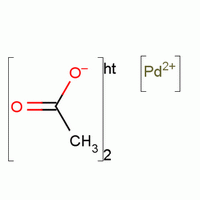Palladium (II) Acetate
-
- Category :
Catalyst and Auxiliary/Catalyst
- CAS NO : 3375-31-3
- EC NO : 222-164-4;243-333-9
- Molecular Formula : C4H6O4Pd
- Main Specifications : Brownish red crystalline powder; Purity:99%
- Synonyms : hexakis(acetato)tripalladium;bis(acetato)palladium;Palladiumacetatemingoldbrownxtl;Acetic acid palladium(II) salt;Palladium(II)acetat;Palladousacetate;palladium-acetic acid (1:2);acetate, palladium(2+) salt (1:1);palladium acetate;;Acetic acid, palladium salt;Acetic acid, palladium salt (1:2);palladium(2+) diacetate;Palladium diacetate;Palladium(II) acetate trimer;Palladous acetate;
Package: 25 kg Cardboard drum with plastic bag inside
Uses : Catalysts for the formation of allyl acetates; catalysts for selenohydride reactions forming triple bonds; catalysts for the Heck arylation of olefins; catalysts for cyclocarbonylation reactions; catalysts for the Buchwald-Hartwig amination reaction; cata
Molecular Structure:

Product description:
Palladium acetate (CAS#3375-31-3) is a precious metal catalyst, brown-red crystalline powder, purity up to 99%, which can be used in cross-coupling reactions such as Heck arylation, Buchwald-Hartwig amination and intramolecular coupling reactions, in cyclization and carbonylation reactions such as cyclocarbonylation and palladium-catalyzed intramolecular cyclization, and in addition and functional group transformations, such as selenohydrogenation of the triple bond and allylic acetic acid ester formation, as non-homogeneous catalytic precursors, e.g. as non-halogenated palladium(II) complexes. The regular package is cardboard drums lined with plastic bags, sealed and stored in a cool and dry place.
